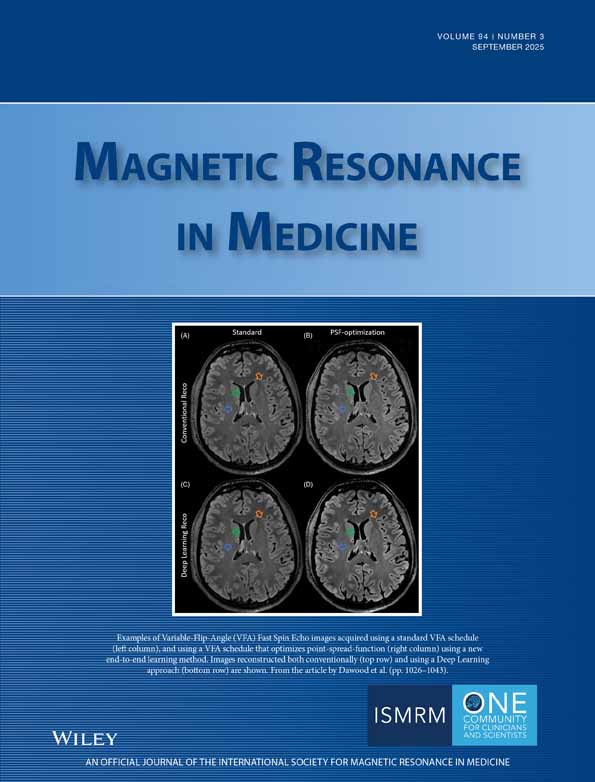Observation of significant signal voids in images of large biological samples at 11.1 T
Barbara L. Beck
The McKnight Brain Institute, University of Florida, Gainesville, Florida
Search for more papers by this authorKelly Jenkins
The McKnight Brain Institute, University of Florida, Gainesville, Florida
Search for more papers by this authorKyle Padgett
Department of Nuclear and Radiological Sciences, University of Florida, Gainesville, Florida
Search for more papers by this authorJeffrey Fitzsimmons
The McKnight Brain Institute, University of Florida, Gainesville, Florida
Department of Neuroscience, University of Florida, Gainesville, Florida
Search for more papers by this authorCorresponding Author
S.J. Blackband
The McKnight Brain Institute, University of Florida, Gainesville, Florida
Department of Radiology, University of Florida, Gainesville, Florida
The Center for Structural Biology, University of Florida, Gainesville, Florida
The National High Magnetic Field Laboratory, Tallahassee, Florida
Department of Neuroscience, University of Florida, Gainesville, FL 32610===Search for more papers by this authorBarbara L. Beck
The McKnight Brain Institute, University of Florida, Gainesville, Florida
Search for more papers by this authorKelly Jenkins
The McKnight Brain Institute, University of Florida, Gainesville, Florida
Search for more papers by this authorKyle Padgett
Department of Nuclear and Radiological Sciences, University of Florida, Gainesville, Florida
Search for more papers by this authorJeffrey Fitzsimmons
The McKnight Brain Institute, University of Florida, Gainesville, Florida
Department of Neuroscience, University of Florida, Gainesville, Florida
Search for more papers by this authorCorresponding Author
S.J. Blackband
The McKnight Brain Institute, University of Florida, Gainesville, Florida
Department of Radiology, University of Florida, Gainesville, Florida
The Center for Structural Biology, University of Florida, Gainesville, Florida
The National High Magnetic Field Laboratory, Tallahassee, Florida
Department of Neuroscience, University of Florida, Gainesville, FL 32610===Search for more papers by this authorAbstract
Proton MRI of large biological samples were obtained on an 11.1 T / 40 cm instrument. Images were obtained of a fixed human brain and a large piece of fresh beef. The proton MR images demonstrate severe distortions within these conductive samples, indicative of shortened electrical wavelengths and wave behavior within the sample. These observations have significant implications with respect to the continuing evolution of MR to higher magnetic field strengths on large samples, particularly on humans. Magn Reson Med 51:1103–1107, 2004. © 2004 Wiley-Liss, Inc.
REFERENCES
- 1 Lauterbur PC. Image formations by induced local interactions: examples employing nuclear magnetic resonance. Nature 1973; 242: 190–191.
- 2 DD Stark, WG Bradley (eds.). Magnetic resonance imaging. St. Louis: Mosby; 1999.
- 3 R Edelman, N Hesselink, M Zlatatkin (eds.). Clinical magnetic resonance imaging. New York: Harcourt Brace; 1996.
- 4 Bottomley PA, Andrew ER. RF magnetic field penetration, phase shift and power deposition in biological tissue: implications for NMR imaging. Phys Med Biol 1978; 23: 630–643.
- 5 Bottomley PA, Reddington RW, Edelstein WA, Schenck JF. Estimating radiofrequency power deposition in body NMR imaging. Magn Reson Med 1985; 2: 336–349.
- 6 Vaughan JT, Garwood M, Collins CM, Liu W, DeLa Barre L, Adriany G, Andersen P, Merkle H, Soebel R, Smith MB, Ugurbil K. 7T vs. 4T RF power, homogeneity, and signal-to-noise comparison in head images. Magn Reson Med 2001; 46: 24–30.
- 7 Kangarlu A, et al. Dielectric resonance phenomena in ultra high field MRI. Comput Assist Tomogr 1999; 23: 821–831.
- 8 Beck BL, Fitzsimmons JR, Crozier S. Blackband, SJ. Quadrature coaxial reentrant cavity (ReCav) coils. In: Proc 10th Annual Meeting ISMRM, 2002, Honolulu. p 765.
- 9 Beck BL, et al. Progress in high field MRI at the University of Florida. MAGMA 2002; 13: 152–157.
- 10 Beck BL, et al. Geometry comparisons of an 11T coaxial reentrant cavity (ReCav) coil. Concepts Magn Reson B (Magn Reson Eng) 2003; 18B: 24–27.
- 11 Simmons A, Tofts PS, Barker GJ, Arridge SR. Sources of intensity nonuniformity in spin echo images at 1.5 T. Magn Reson Med 1994; 32: 121–128.
- 12 Gabriel S, Lau RW, Gabriel C. The dielectric properties of biological tissues. II. Measurements in the frequency range 10 Hz to 20 GHz. Phys Med Biol 1996; 41: 2231–2249.
- 13 Gabriel S, Lau RW, Gabriel C. The dielectric properties of biological tissues. III. Parametric models for the dielectric spectrum of tissues. Phys Med Biol 1996; 41: 2271–2293.
- 14 Collins CM, Smith MB. Signal-to-noise ratio and absorbed power as functions of main magnetic field strength, and definition of “90°” RF pulse for the head in the birdcage coil. Magn Reson Med 2001; 45: 684–691.
- 15 Ibrahim TS, Lee R, Baertlein BA, Yu Y, Robitaille P-ML. Computational analysis of the high pass birdcage resonator: finite difference time domain simulation for high field MRI. Magn Reson Imag 2000; 18: 835–843.
- 16 Collins CM, Yang QX, Wang JH, Zhang X, Liu H, Michaeli S, Zhu X-H, Adriany G, Vaughan JT, Anderson P, Merkle H, Ugurbil K, Smith MB, Chen W. Different excitation and reception distributions with a single-loop transmit-receive surface coil near a head sized spherical phantom at 300 MHz. Magn Reson Med 2002; 47: 1026–1028.
- 17 Yang QX, Wang J, Zhang X, Collins CM, Smith MB, Liu H, Zhu X-H, Vaughan JT, Ugurbil K, Chen W. Analysis of wave behavior in lossy dielectric samples at high field. Magn Reson Med 2002; 47: 982–989.
- 18 Ibrahim TS, et al. Effect of RF coil excitation on field inhomogeneity at ultra high fields: a field optimized TEM resonator. Magn Reson Imag 2001; 19: 1339–1347.
- 19 Alsop DC, Connick TJ, Mizsei G. A spiral volume coil for improved RF field homogeneity at high static magnetic field strength. Magn Reson Med 1998; 40: 49–54.




